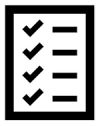Learning Objectives
By the end of this module, you should be able to:
- Understand the process of customer validation in getting out of the building
- Explain how an interviewer can gain valuable information from potential customers
- Interview customers for your own startup
Now that we have an MVP, we need to get some feedback from customers so that we can test the assumptions about our business model. Traditionally this was done from behind a desk, however this is not the best way to get feedback. In an ideal world, we could observe our target customer in many different contexts. As a thought experiment, imagine how much you could learn from customers by being able to observe them and “get inside their heads” for a few days? You would likely learn something interesting about their jobs, pains and gains – especially in how they relate to your business idea. We will review thee concepts below.
In essence, Getting out of the Building is our attempt at understanding the customer in the best way possible. Traditionally entrepreneurs performed “desk research” in an attempt to understand their customer. We can probably guess that this doesn’t work as well as testing our MVPs and doing so in a face-to face setting. The video below briefly further describes why we do this activity:
Getting out of the building is one of the activities that takes many people out of their comfort zones. Luckily there are ways to make this process go smoothly and effectively. Steve Blank’s Blog is a great resource for this. Have a look at the four videos he uses to coach entrepreneurs on this process:
Walk through these steps and plan your interviews. One additional point that should be made clear is that the best interviews are with people who are your ideal customers. If your customers are tourists to Newfoundland, then try and get in touch with some of these tourists. If you are selling to other businesses, then it is less useful to talk to end consumers. If your target market is all online, try and complete this process through online channels.
At the risk of sounding obvious, as you speak with the potential customer it is important to listen. If you look at the next section of videos in Steve Blank’s blog, it is titled “Understanding What the Customer Is Telling You”. Have a look at the videos in these sections. These considerations are important since customers may be dropping hints that you should pick up on. They may also not be truthful, or may even be distracted. Once you complete your interviews, it will be up to you to sift through the information you received, and it is often these small cues that give you the most information. After watching the videos, make some notes on the mistakes you would like to avoid, and how you can avoid the pitfalls of not listening to a customer.
Even after some careful planning, the customer interview takes practice. Even designing the questions can take a bit of tweaking. As a general rule, start out with open-ended questions for your interviews. For example, instead of asking “would you be interested in an ATV tour?”, ask “what is it that appeals or does not appeal to you about taking an ATV tour?” It is very important to get this right. A “yes” does not tell us much, but an open-ended question tells us more about why a customer feels the way they do.
To help outline some of the other recommended tips and tricks for getting out of the building, have a look at the Slides/Videos section of Steve Blank’s Blog: https://steveblank.com/slides/. If you scroll down, you will notice that we have already looked at the “Before leaving the building” section. Now, have a look through the videos in the “Outside of the building” section.

- Let’s get out of the building and get some feedback. While choosing the number of customers to interview can be quite arbitrary, lets aim for 20 customers if your business is targeted at an end consumer. You may have to do less if you target businesses as there are few of them (but don’t limit yourself)!
- A spreadsheet is a good tool to plan and record the interviews. You can use one on a laptop or desktop, or use Google Sheets.
- Make a list of potential contacts and make a list of these in Google Sheets. Next to each contact you can also list some potential open-ended interview questions on information you need.
- Conduct the interviews and record the information through audio or by inputting the data into your spreadsheets
- Summarize your main findings in 3-4 sentences after each interview.

